Are you trying to get verified on OpenSea?
Perhaps you’ve recently launched your own NFT project and want to know how to get verified on OpenSea?
Well, you’re not alone because getting an account or a collection verified with a blue checkmark is probably one of the most exclusive things you can strive for in the NFT space right now.
Getting verified on OpenSea comes with a number of benefits, but unfortunately, it’s a status that is extremely hard to achieve and it doesn’t always follow a strict set of rules.
In this article, you’ll learn what it takes to get the infamous blue checkmark as well as how to get verified on OpenSea the proper way.
So let’s get right to it.
Key Points (tl;dr)
- Verified accounts and collections on OpenSea not only benefit from increased social status, they also benefit from better visbility in promotions.
- OpenSea verification is normally limited to high-profile people and organizations, as well as very successful NFT projects with at least 100 ETH in trading volume.
- Accounts that have previously violeted the OpenSea terms of service are usually not eligible for verification and a verified status can even be revoked after the fact.
- In order to get verified you must apply via OpenSea’s verification form. Once you’ve completed the form and provided proof of identity, your submission will be reviewed by the OpenSea team.
For a step-by-step guide on how to get verified on OpenSea, PLEASE READ THE FULL ARTICLE.
Like this content? Then share it!
The Truth: How to Get Verified on OpenSea
www.tokenizedhq.com
Here’s the answer. Great article by @ChrisHeidorn right here: https://tokenizedhq.com/how-to-get-verified-on-opensea/
What Are the Benefits of Getting Verified on OpenSea?
Accounts and collections that receive a blue checkmark benefit from significantly more public exposure as well as trust amongst buyers. OpenSea verification reduces the risk of fraud and also increases the social status of both creators and buyers of verified NFT collections.
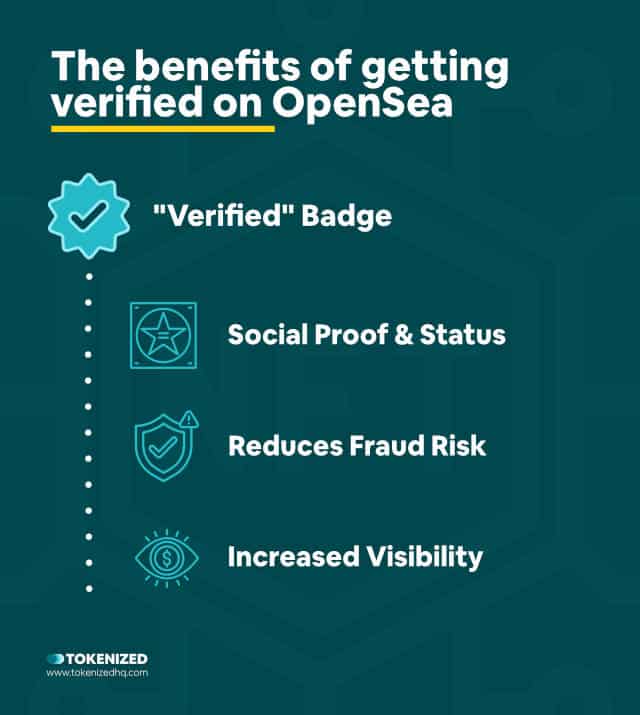
Getting your account or an NFT collection verified on OpenSea comes with a lot of benefits.
You see, in a world that is dominated by social currency, having a blue checkmark is a massive symbol of social proof.
Why do you think verification is so popular on social media platforms?
Not only does it prove that your account is genuine, but it also says that you are a relevant figure within your industry or community.
In the context of OpenSea, getting a blue checkmark for your account or for your collection isn’t necessary in order to become successful, but it usually means that you already are successful.
OpenSea verification not only helps prevent people from getting scammed by fake collections, but it also increases the visibility of your NFTs.
So, if you’re trying to figure out how to get views on OpenSea, then knowing how to get verified on OpenSea will go a long way in helping you achieve that goal.
What Are the Requirements to Get Verified on OpenSea?
As a minimum requirement, you must have either purchased or sold at least 1 NFT in the past 3 months. Your profile also needs to have been fully completed and ideally you should be notable public figure. Additional requirements include 100 ETH trading volume for collections. OpenSea verification is by intentionally and inherently exclusive in order to maintain its symbolic value.
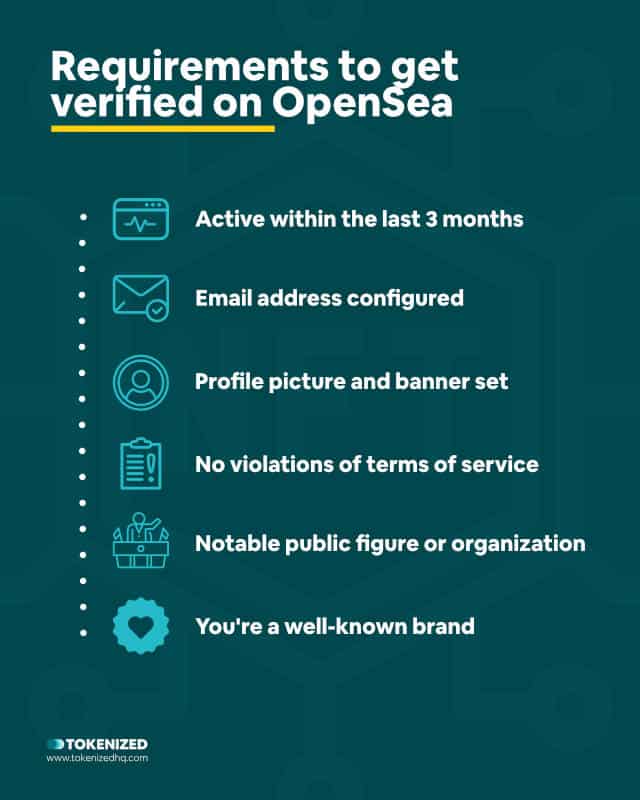
Unless you’re a relevant public figure, it’s actually very difficult to get verified on OpenSea.
Blue checkmarks are usually reserved for high-profile public figures or organizations.
And if don’t fall into that category, your collection will need to have a trading volume of at least 100 ETH before they’ll even consider it.
Here are some basic criteria, although the specific requirements can vary on a case-by-case basis:
- You must have purchased or sold at least 1 NFT within the past 3 months
- Your account must have an email configured in its settings
- You must have a profile picture and a banner configured (need an OpenSea banner template?)
- No previous violations of OpenSea’s terms of service
- You’re a notable public figure or organization
- You represent a known brand that may be exposed to fraud risk
It always helps when you can show examples of previous verification on other social media platforms.
That’s proven to be quite effective in figuring out how to get verified on OpenSea.
But in the end, given the centralized nature of OpenSea, you’re ultimately subject to the whims of their management.
That’s also why a lot of people have recently been moving to other OpenSea alternatives.
Who Is Ineligible for OpenSea Verification?
In a nutshell: If you’ve engaged in any sort of deceptive or fraudulent behaviour, either recently or in the past or have violated any of OpenSea’s terms, then you are not eligible for OpenSea verification. Derivative projects or spin-offs, as a rule, are not verified by OpenSea in order to avoid suggesting any relationship to the original projects.
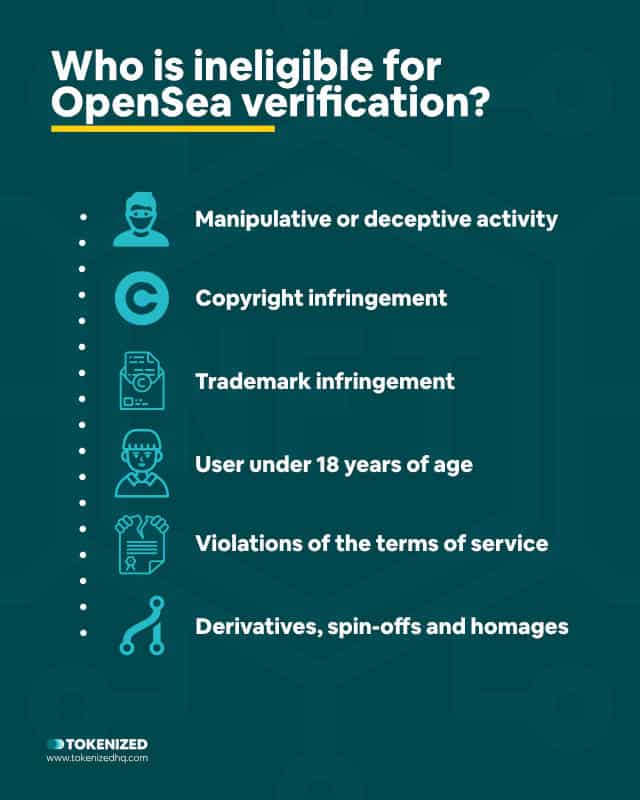
In some cases, it might not even matter if you fulfill most of the criteria mentioned above.
Some accounts simply aren’t eligible, so there’s little point in trying to figure out how to get verified on OpenSea.
Factors that might lead to this include:
- Accounts that engage in manipulative or deceptive buying, selling, bidding and offering.
- Accounts that make unauthorized use of copyrighted material or trademarks.
- Accounts held or operated by people under the age of 18 years.
- Anything that directly or indirectly violates OpenSea’s terms of service.
Please also bear in mind that OpenSea, as a rule, does not verify spin-off, homage, or remix collections at this time (e.g. 0xApes and similar projects).
This is done in order to protect users from misinterpreting these collections as having an official relationship with the original collection.
Every verification is a manual process that involves a considerable amount of vetting.
There is no right to verification and it’s entirely at OpenSea’s discretion.
Can You Lose Your OpenSea Verification?
Yes, you can lose your verified status on OpenSea if you engage in any activity that would disqualify you from verification or you violate OpenSea’s terms of service.
Obviously, what can be earned can also be lost.
If you engage in any sort of activity that might disqualify you from OpenSea verification, then it’s entirely possible that your verified status might be revoked.
So if you’re ever lucky enough to get verified on OpenSea, make sure you stick to the rules because you could easily lose it in an instant.
And depending on the severity, your account might even be banned from OpenSea altogether.
How to Get Verified on OpenSea Step-By-Step
If after reading all of the above you still feel confident that your account or your collection might fulfill the relevant criteria for OpenSea verification, then it’s time to fill out your application.
The process on how to get verified on OpenSea is actually quite simple.
But we’re going to walk you through it step-by-step anyway:
Step 1: OpenSea verification form
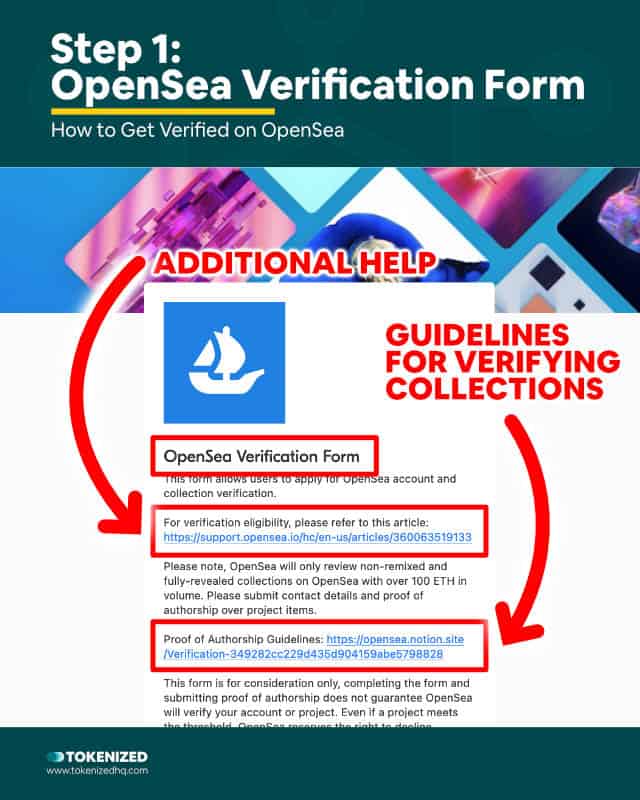
Start off by opening the browser of your choice and navigating to the official OpenSea Verification Form: https://airtable.com/shr6kWzFZ4gWdYE6C
You’ll be presented with a short summary of the requirements for verification.
At the bottom of the screen, you’ll two checkboxes for “Account Verification” and “Collection Verification”.
Depending on what sort of verification you are trying to achieve, you’ll be confronted with different fields and questions to fill out.
Step 2: Complete the form
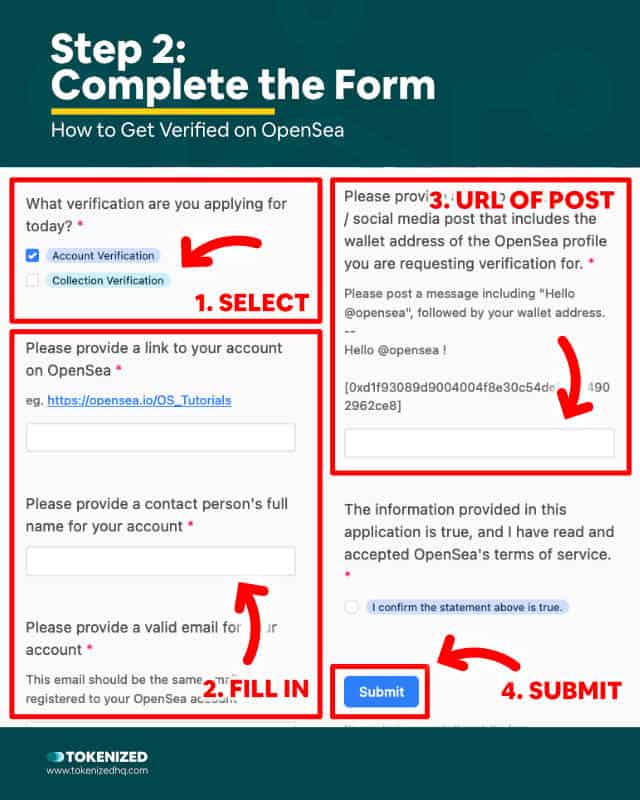
If you’ve chosen to verify your account you will be asked to provide the following pieces of information:
- Link to your account on OpenSea
- Your full name
- A valid email address for your account
- Proof of identify via a LinkedIn, GitHub, Twitter or Instagram profile
- Link to a social media post with the wallet address of the profile you want to verify
Here’s an example of such a post on Twitter.
Finally, confirm that the information you’ve provided is true and you’ve read and accepted OpenSea’s terms of service.
Now, perhaps you’re more interested in knowing how to get verified on OpenSea for your collection.
Well, if you’ve chosen to verify a specific NFT collection, then the questions you’ll be asked are slightly different:
- The project’s name
- Link to your project’s collection on OpenSea
- Total trading volume of your collection (in ETH)
- Contact email for the project
- Proof of identify via a LinkedIn, GitHub, Twitter or Instagram profile
- Documents that demonstrate proof of authorship over the project (see OpenSea’s proof of authorship guidelines for details)
- 13 separate statements that you must confirm to be true (otherwise you’d be in breach of OpenSea’s terms of service)
Once you’ve completed the form, you can click the “Submit” button at the very bottom.
You’ll have to wait for at least 5 business days until you receive a response from OpenSea, but it might also take a lot longer.
Step 3: How to post your wallet address
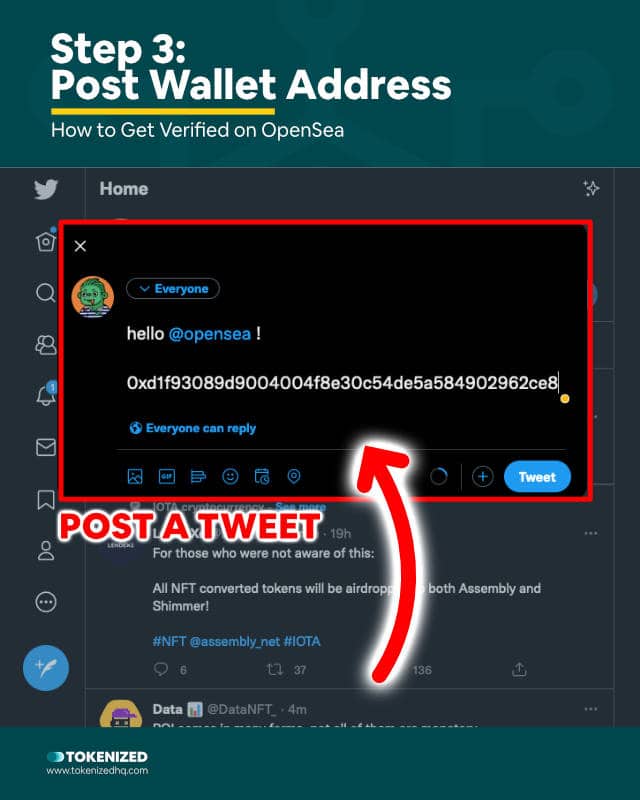
Some people are overwhelmed by the proof of identity requirement, when in fact it’s very easy to do.
You can copy your OpenSea wallet address by navigating to your profile and simply copying the Ethereum address under your username.
Then go to one of the eligible social media platforms and post the following text (replace the address with your own wallet address, duh!):
Hello @opensea !
[0xd1f93089d9004004f8e30c54de5a584902962ce8]
Once you’ve done that, make sure you copy the direct link to the post.
Usually, you can do that by simply tapping on the share icon and then selecting “Copy Link”.
Then just paste it into the application form and that’s it.
And now you wait.
You might be impatient, but I’m afraid this is the only way how to get verified on OpenSea.
Conclusion
Applying for OpenSea verification is actually very easy.
Meeting the necessary requirements and truly figuring out how to get verified on OpenSea is the real challenge.
Most people will never get to the point where they are considered relevant enough to successfully get verified on OpenSea.
But those who do will become part of an elite community of NFT leaders.
Good luck!
Here at Tokenized, we want to help you learn as much as possible about the coming NFT revolution. We help you navigate this fascinating new world of non-fungible tokens and show you how you can integrate tokenization into your own business.



